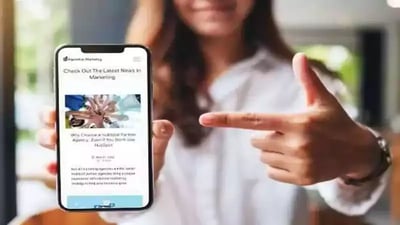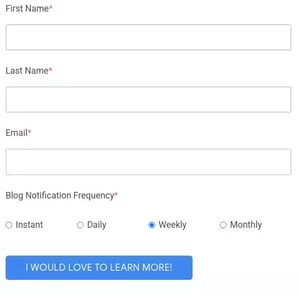8 astuces pour booster vos conversions
Que vous soyez fan ou non, il est indéniable que les pages d'atterrissage jouent un rôle crucial dans toute campagne de marketing de contenu réussie - en particulier dans la génération de leads.
Cependant, il est temps de prendre des mesures si vous n'obtenez pas les résultats escomptés de vos pages d'atterrissage. La mise en œuvre de certaines des huit tactiques suivantes peut donner un coup de fouet à vos pages d'atterrissage et libérer tout leur potentiel pour générer des leads et des conversions.

Qu'est-ce qu'une page d'atterrissage ?
Lorsqu'un visiteur clique sur un lien dans un courriel, une publicité ou un appel à l'action dans le cadre d'une campagne de marketing, il atterrit sur une page d'atterrissage.
Une page d'atterrissage vise à convertir les visiteurs en prospects ou en clients en leur fournissant des informations pertinentes sur votre produit ou service et en les encourageant à entreprendre une action spécifique, comme s'inscrire à votre liste d'adresses électroniques, télécharger un contenu à accès limité, un livre électronique gratuit ou effectuer un achat.
Pourquoi les conversions des pages d'atterrissage sont-elles importantes ?
-
Le taux de conversion moyen des pages d'atterrissage est d'environ 2,55 %, ce qui signifie que sur 100 visiteurs d'une page d'atterrissage, seuls 2,55 se convertissent en prospects ou en clients. Il s'agit d'un taux de conversion relativement faible, et il y a donc beaucoup à faire pour l'améliorer.
-
Les pages d'atterrissage comportant un appel à l'action clair et concis ont un taux de conversion supérieur de 25 % à celles qui n'en comportent pas. Il est essentiel d'inclure un appel à l'action clair sur votre page d'atterrissage, car il guide les visiteurs pour qu'ils entreprennent facilement l'action souhaitée. Plutôt que d'utiliser des phrases génériques comme "Contactez-nous", essayez d'utiliser un langage plus convaincant comme "Obtenez un devis gratuit en un seul clic !" Plus il est facile pour les visiteurs de passer à l'action, plus ils sont susceptibles de se convertir en prospects ou en clients.
-
Les pages d'atterrissage dotées de visuels de haute qualité ont un taux de conversion de 123 % supérieur à celles qui en sont dépourvues. Les visuels sont essentiels pour renforcer l'attrait de votre page d'atterrissage et transmettre votre message plus efficacement. Ils rompent avec le texte et ajoutent de l'intérêt à votre page. Vous pouvez utiliser des images de vos produits ou services ou même des infographies pour expliquer vos offres de manière plus concise.
-
Les pages d'atterrissage contenant des témoignages et des preuves sociales ont un taux de conversion de 92 % supérieur à celles qui n'en contiennent pas. Les témoignages et les preuves sociales sont essentiels pour établir la confiance et la crédibilité des visiteurs. Vous pouvez présenter les commentaires de clients satisfaits ou afficher les récompenses obtenues par votre marque. Ces éléments peuvent avoir un impact significatif sur la capacité de votre page d'atterrissage à convertir les visiteurs en clients fidèles.
-
Les pages d'atterrissage optimisées pour les appareils mobiles ont un taux de conversion de 61 % supérieur à celles qui ne le sont pas. Étant donné le nombre croissant de personnes qui utilisent leurs appareils mobiles pour naviguer sur Internet, il est essentiel de veiller à ce que votre page d'atterrissage soit optimisée pour l'affichage sur mobile. Facilitez la navigation et la lecture de votre contenu sur les appareils mobiles pour augmenter les taux de conversion.
Si la génération de leads ne fonctionne pas, il convient d'examiner les performances de vos pages d'atterrissage.
1. Des titres, des titres, des titres
Selon copyblogger, seuls 20 % des lecteurs lisent au-delà du titre. Regardez à nouveau ce chiffre. 20%. C'est le chiffre exact. Cela signifie que si vous voulez attirer l'attention de la plupart des visiteurs de votre page, vous devez rédiger des titres qui les captivent. Soyez clair et concis ; n'utilisez pas de mots-clés à la mode dans votre secteur d'activité ou pour le référencement; faites une affirmation, puis poursuivez-la.
Conseil : Abordez directement un point de douleur. L'une des meilleures façons d'attirer l'attention de vos lecteurs est de traiter directement d'un problème qu'ils rencontrent. Par exemple, si vous vendez un produit qui aide les gens à perdre du poids, votre titre pourrait être "Perdez du poids rapidement et facilement avec ce nouveau produit".
Exemple :
-
-
Titre : " Lose Weight Fast and Easy with This New Product " (Perdre du poids rapidement et facilement avec ce nouveau produit)
-
Corps : Êtes-vous fatigué de lutter pour perdre du poids ? Vous avez l'impression d'avoir tout essayé, mais rien ne semble fonctionner ? Si c'est le cas, vous n'êtes pas seul. Des millions de personnes dans le monde luttent pour perdre du poids. Mais il y a de l'espoir. Un nouveau produit commercialisé peut vous aider à perdre du poids rapidement et facilement.
-
Ce titre est convaincant parce qu'il s'adresse directement à la souffrance des personnes qui luttent pour perdre du poids. Il promet également une solution : le produit peut aider les gens à perdre du poids rapidement. Il s'agit d'une offre très attrayante qui attirera probablement l'attention des personnes désireuses de perdre du poids.
2. Assurez-vous que votre page d'atterrissage est pertinente pour votre public cible.
Votre page de renvoi doit être adaptée aux besoins et aux intérêts de votre public cible. Cela signifie que vous devez utiliser le bon langage, les bonnes images et le bon ton de voix pour toucher le buyer persona ciblé.
Étudiez les objectifs et les intentions de votre public cible lorsqu'il arrive sur votre page d'atterrissage. Réfléchissez aux informations qu'ils recherchent et adaptez votre contenu en conséquence. Anticipez leurs questions, leurs objections et leurs désirs, en leur apportant des réponses claires et convaincantes qui les guident vers l'action souhaitée.
Exemple : Supposons que vous soyez un éditeur de logiciels qui vend une solution de gestion de la relation client (CRM) aux petites entreprises. Votre public cible est constitué de propriétaires de petites entreprises à la recherche d'un moyen de gérer leurs pistes de vente et leurs relations avec les clients.
-
-
Votre page de renvoi doit être adaptée aux besoins de ces propriétaires de petites entreprises. Vous devez utiliser un langage qu'ils comprennent, comme "génération de prospects" et "gestion de la relation client".
-
Utilisez des images en rapport avec leur activité, par exemple des images de personnes travaillant dans un bureau ou utilisant un ordinateur.
-
Votre appel à l'action doit être clair et concis, comme "Inscrivez-vous pour un essai gratuit aujourd'hui !".
-
3. Utilisez un appel à l'action clair et concis.
Votre page d'atterrissage doit comporter un appel à l'action clair et concis qui indique aux visiteurs ce que vous voulez qu'ils fassent.
-
Créez un sentiment d'urgence : Encouragez l'action immédiate en incorporant un sentiment d'urgence dans vos CTA. Utilisez des expressions telles que "Offre limitée dans le temps", "Agissez maintenant" ou "Disponible uniquement pendant les prochaines 24 heures". L'urgence incite les visiteurs à agir, de peur de manquer une occasion précieuse.
-
Utilisez un langage orienté vers l'action : Faites en sorte que votre CTA soit orienté vers l'action et convaincant. Utilisez des verbes forts qui donnent un sentiment d'autonomie et d'enthousiasme. Voici quelques exemples : "Commencez", "Rejoignez-nous maintenant", "Abonnez-vous à notre lettre d'information" ou "Demandez votre essai gratuit". Ce type de langage incite les visiteurs à s'engager dans l'action souhaitée.
-
Mettez en avant les avantages : Reliez le CTA aux avantages spécifiques que les visiteurs recevront s'ils passent à l'action. Par exemple, au lieu d'un simple "Inscrivez-vous", essayez "Commencez à économiser de l'argent dès aujourd'hui" ou "Débloquez des trucs et astuces exclusifs". Communiquez la valeur qu'ils obtiendront, ce qui les incitera à cliquer.
Exemple : Imaginons que votre entreprise vende des cours en ligne. Votre page d'atterrissage pourrait contenir un appel à l'action comme celui-ci :
Inscrivez-vous à notre essai gratuit et commencez à apprendre dès aujourd'hui !
Cet appel à l'action est clair, concis et orienté vers l'action. Il crée également un sentiment d'urgence en disant "Commencez à apprendre aujourd'hui". Enfin, il met l'accent sur les avantages de l'action en mentionnant "essai gratuit".
4. Ne pas encombrer le site et le rendre facile à utiliser
Évitez d'encombrer votre page de renvoi avec trop d'informations ou de distractions inutiles. Les visiteurs doivent pouvoir trouver rapidement et facilement ce qu'ils cherchent. Et cela inclut les liens vers le reste de votre site web. Oui, je sais. "Je croyais que nous voulions garder les visiteurs sur notre site ?" Vous les gardez sur votre site, mais pas avec de nombreux liens qui les emmèneront partout. Les pages d'atterrissage ne visent qu'une chose et une seule : les conversions.
Lorsque quelqu'un clique sur un lien vers votre page d'atterrissage dans une publication sur les médias sociaux, il cherche quelque chose. Ils veulent de l'aide pour résoudre le problème que votre lien leur a dit que vous alliez résoudre. Lorsqu'ils arrivent sur votre page d'atterrissage, tout ce qu'ils doivent voir, c'est comment vous allez résoudre ce problème et un bouton sur lequel ils peuvent cliquer pour obtenir plus d'informations.
-
Concentrez-vous sur un seul message : votre page de renvoi doit contenir un message clair et concis. N'essayez pas de faire entrer trop d'informations dans une seule page.
-
Utilisez des images etdes vidéos de haute qualité. Les images et les vidéos peuvent contribuer à découper votre texte et à rendre votre page d'atterrissage plus attrayante sur le plan visuel. Elles peuvent également vous aider à raconter votre histoire et à transmettre votre message de manière plus efficace.
-
Utilisez un appel à l'action clair et concis. Dites aux visiteurs ce que vous voulez qu'ils fassent. Voulez-vous qu'ils s'inscrivent à votre lettre d'information ? Qu'ils téléchargent un livre blanc ? Qu'ils fassent un achat ? Veillez à ce que votre appel à l'action soit clair et facile à comprendre.
Exemple : Imaginons que votre entreprise vende des cours en ligne. Votre page de renvoi pourrait ressembler à ceci :
Titre : Apprenez de nouvelles compétences et faites progresser votre carrière grâce à nos cours en ligne.
Texte du corps : Nos cours en ligne sont conçus pour vous aider à acquérir de nouvelles compétences et à faire progresser votre carrière. Nous proposons des cours sur divers sujets, notamment les affaires, la technologie et le développement personnel. Des instructeurs expérimentés sont disponibles 24 heures sur 24 et 7 jours sur 7.
Appel à l'action : Inscrivez-vous pour un essai gratuit dès aujourd'hui et commencez à apprendre !
Cette page d'atterrissage est claire et facile à utiliser. Elle contient un message clair et concis, des images et des vidéos de haute qualité et un appel à l'action clair et concis.
5. Utiliser des visuels forts
Les visuels peuvent aider à découper le texte et à rendre votre page d'atterrissage plus attrayante sur le plan visuel. Ils peuvent également vous aider à faire passer votre message plus efficacement.
Sélectionnez des images qui sont non seulement pertinentes, mais aussi de grande qualité. Ces images doivent être directement associées à votre produit, à votre service ou à votre message, tout en restant cohérentes avec l'esthétique de votre marque. Évitez d'utiliser des photos génériques ou des photos de stock qui peuvent sembler clichées ou sans rapport avec votre offre.
Exemple : Imaginons que vous soyez une agence de marketing qui aide les entreprises à développer leur présence en ligne. Votre page de renvoi pourrait utiliser des images de chefs d'entreprise heureux et prospères qui lisent votre blog et y trouvent des informations complémentaires. Ces images doivent être en rapport avec votre produit, de haute qualité, visuellement attrayantes et cohérentes avec votre marque.
-
-
Utilisez les images pour raconter une histoire : vos images peuvent contribuer à raconter l'histoire de votre produit ou service. Elles peuvent montrer comment votre produit peut bénéficier à vos clients ou résoudre leurs problèmes.
-
Utilisez des images pour attirer l'attention sur votre appel à l'action. Votre appel à l'action doit être l'élément le plus important de votre page d'atterrissage. Utilisez des images pour attirer l'attention sur votre appel à l'action et inciter les visiteurs à cliquer.
-
6. Optimisez votre formulaire de prise de contact
Simplifiez votre formulaire de prise de contact en ne demandant que les détails essentiels. Vous n'avez pas besoin de connaître le nom de l'animal de compagnie de votre enfance ou de lui faire prêter serment sur votre livre blanc. Tout ce dont vous avez besoin, c'est de leur consentement à les contacter et d'un moyen de le faire. Restez simple et direct pour maximiser vos taux de conversion.
La simplicité est essentielle, non seulement dans votre vie personnelle, mais aussi dans vos formulaires de prise de contact. Même si vous avez besoin d'une douzaine d'informations, divisez-les en petits morceaux. Ne demandez que deux éléments à la fois et affichez une barre de progression en haut du formulaire pour tenir votre client potentiel au courant. Il se sentira ainsi valorisé et respecté, sachant que vous appréciez la valeur de son temps. Il aura fourni tous les détails nécessaires et sera bientôt sur la bonne voie.
Exemple : Inscription à un blog. Voici un exemple de formulaire de prise de contact :
Texte du corps : Recevez nos lettres d'information par courrier électronique, des notifications d'articles de blog, d'événements ou de séminaires en ligne, directement dans votre boîte aux lettres électronique. Vous pouvez vous désabonner ou modifier vos préférences et fréquences à tout moment.
Champs du formulaire :
-
-
-
Nom
-
Adresse électronique
- Fréquence à laquelle vous souhaitez être informé(e)
-
-
Bouton d'envoi : J'aimerais en savoir plus !
7. Optimisez votre page d'atterrissage pour les appareils mobiles
De plus en plus de personnes utilisent leurs appareils mobiles pour naviguer sur Internet. Veillez à ce que votre page d'atterrissage soit optimisée pour les appareils mobiles afin que les visiteurs puissent facilement la consulter et interagir avec elle sur leurs smartphones et leurs tablettes.
-
Une approche responsive design doit être mise en œuvre pour permettre aux éléments tels que le texte, les images et les boutons de s'ajuster automatiquement et de se mettre à l'échelle de manière appropriée, offrant ainsi une expérience de visualisation cohérente sur différentes tailles et résolutions d'écran.
-
Optimisez votre page de destination pour obtenir des temps de chargement rapides en compressant les images, en réduisant le code et en utilisant des techniques de mise en cache pour conserver l'attention des internautes. Il est essentiel de tester régulièrement la vitesse de votre page à l'aide d'outils tels que Google PageSpeed Insights et de procéder aux optimisations nécessaires pour maintenir l'attention de vos visiteurs.
-
Assurez-vous que vos formulaires sont adaptés aux mobiles en les simplifiant et en utilisant des champs de saisie optimisés, des cases à cocher et des menus déroulants faciles à utiliser sur les écrans tactiles. Pour augmenter les taux de conversion, minimisez les champs obligatoires et réduisez les frictions pour les utilisateurs mobiles.
8. Effectuez des tests A/B
Certains aspects d'une page d'atterrissage peuvent attirer ou repousser les visiteurs. Le moyen le plus simple de déterminer si votre taux de conversion pourrait être amélioré est de procéder à des tests A/B sur certains de ces aspects.
-
Lancez deux versions de votre titre. Voyez laquelle entraîne le plus de conversions.
-
Utilisez deux couleurs pour votre bouton CTA.
-
Lancez deux boutons CTA de forme différente.
-
Essayez un texte différent pour votre CTA ; "Cliquez ici pour obtenir votre étude de cas gratuite" ou "Obtenez votre étude de cas gratuite" peut faire la différence.
Il est important de ne modifier qu'un seul aspect pour chaque test. Si vous changez tout en même temps, vous ne pourrez pas déterminer quel changement a entraîné une augmentation des conversions.
En suivant ces huit conseils, vous constaterez une amélioration significative du taux de conversion de vos pages d'atterrissage. Et en recueillant les données des tests A/B de l'astuce n°8, vous saurez exactement quelles astuces ont porté leurs fruits et vous pourrez ainsi maintenir vos chiffres à la hausse à l'avenir !
Ce contenu est disponible en:
- Allemand: 8 Tipps zur Verbesserung der Landing-Page Conversion-Rates
- Anglais: 8 Practical Tips + Strategies to Improve Landing Page Conversion Rates
- Espagnol: 8 Tips + Estrategias para mejorar conversiones de las landing page
- Italien: Landing page: 8 consigli per conversioni
- Roumain: 8 sfaturi pentru a crește conversia pe paginile de destinație
- Chinois: 提高着陆页转化率的 8 项实用技巧和策略













Commentez ci-dessous